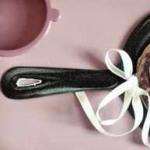How to use a quilling stencil. Quilling for beginners - diagrams and descriptions with photos
Openwork quilling crafts will decorate any window sill, wall, desktop or crib. Refined postcards, panels or small souvenirs made from quilling will surely appeal to young connoisseurs of beauty and those whose hearts invariably yearn for a fairy tale.
The creators of the first quilling crafts are considered to be the monks of medieval Europe. By trimming the gilded edges of religious books and twisting paper strips at the tip of the pen, they made medallions that created an imitation of a gold miniature. No wonder from in English the word "quill" is translated as "bird feather".
Quilling is a unique technique that will help you convey the airiness and lightness of lace patterns.
To create quilling crafts you will need the following tools: awl, tweezers, scissors, glue, as well as a pencil, compass, ruler template.

Before starting work, familiarize yourself with the basic elements of quilling, the so-called modules. It is the different shapes of paper strips twisted into spirals that will allow you to achieve the desired design.

Angel in quilling style
A stylish pendant or a tiny souvenir for a friend - an angel made using the quilling technique will touch anyone. In my opinion, great gift, if you are going to visit.
All parts of the craft, except for the head, consist of “free spiral” modules.
1. Make an angel first sleeves: take four stripes blue color 21 cm long, glued together. Using an awl, twist it into a tight spiral, and then loosen it a little - to a diameter of 20 mm.
You can use special quilling paper, or cut colored double-sided paper yourself, as I did.


2. For dresses angel You will need:
- three “free spiral” modules, consisting of eight glued blue strips, each 21 cm long. The diameter of the spiral on the ruler should correspond to 32 mm;
- two “free spiral” modules, consisting of two blue strips glued together, 21 cm long. The diameter of the finished spiral should be 10 mm.
3. Pens- these are 2 free spirals from 2 glued strips of light pink color, each 21 cm long. Spiral diameter - 10 mm.
4. To create wings toys, make 2 “free spiral” modules, consisting of 4 glued strips white, 21 cm long each. The diameter of the spirals for the wings is 26 mm.

5. For making heads make a tight spiral of 10 light pink strips 21 cm long.
Important! Remove each spiral from the template ruler using tweezers. Carefully lubricate the edge with glue so that the module does not unwind.


6. Give all the spirals, except those 10 mm, a droplet shape.

7. The tiny spirals for the dress will remain unchanged. And the pink ones - for the handles - need to be given the appearance of curved droplets.

8. Assemble the angel: glue all the parts with PVA glue, as shown in the photo. Styrofoam is ideal as a stand - it is easy to stick pins into it.

9. Insert a loop between the head and wings. The angel is ready!

And here are a few more angels in the quilling style - for everyone who has a thorough command of the technique.


Quilled snowdrops. Beautiful spring card
To make a floral card with snowdrops you will need: colored cardboard, an openwork napkin, PVA glue, a long toothpick, white and green quilling paper.

1. Using a toothpick, twist three modules called “free spiral”. These are snowdrop petals.

Form them into three basic elements"eye" by clicking on the spiral from two opposite sides.

2. Take a green strip of paper and form it into a tight spiral. Using the blunt end of a skewer, squeeze out the middle of the spiral, thus forming a “cone” element.


3. Assemble a snowdrop flower: glue the petals and place them in the middle of the cone. If you want to make an unbloomed bud, place only one petal in the cone.
4. Cut out thin stems 8-9 cm long from green paper.

5. Cut ¼ openwork napkin, remove the sharp corner and make a basket blank, folding the edges into the middle.

6. There is very little left - glue all the details of the bouquet onto a cardboard blank and sign the card. I am sure the hero of the occasion will be very happy with such a touching gift: beautiful flowers in quilling style.

Miniature flower in a pot using quilling technique
This tiny planter from the "mee-mee" area is sure to delight the girls. So why not make a pleasant surprise for your beloved friend or deskmate?
In addition to pink, green, white and orange quilling paper, you will need: a wine cork, a toothpick, PVA and scissors.
1. From a cork and a toothpick, make a tool like this for winding paper.

2. Cut six strips orange color and twist them into spirals, loosen them a little.

3. Press the spirals from one side, giving them the shape of droplets.

4. Glue three white strips 7 mm wide and make a fringe. This is the core of the flower.
5. Make a spiral from two green stripes, unravel and squeeze from both sides. So make 2 leaves.
6. Make a tight cone-stem from a green strip 6 mm wide.

7. Make a flower pot from three glued pink strips 1.5 cm wide. Twist a tight roll, squeeze the middle down. Pour PVA glue onto the bottom and glue a circle of paper.
8. Make the grass in the same way as you made the core of the flower. Strip width 10 mm.

9. And now the fun part - assembling the flower.

Here it is - a decorative quilling flowerpot and a new gift for a friend.
What else can be made from quilling
Quilling is always bewitchingly beautiful and very pleasant. Any quilling craft gives a feeling of sophistication and airiness of the depicted object or design. Look what unusual products can be made using the paper rolling technique.
Animals, birds and insects. There are many photos with products using the quilling technique that even a beginner can handle:

Another article by Tatyana Yablonskaya (author of the story about the technique ““) - “ Quilling for Beginners". We have it on our website various works in this technique, but it is much more convenient for those who are just starting to master it, to collect in one article all the initial shapes of the figures, useful tips and subtleties with photographs.
And perhaps in the future you will be able to create masterpieces like this:
But, of course, it’s better to start with the basics. Our step by step description manufacturing of basic elements.

« Twig"It turns out if the spirals are twisted on one side.

« Curl" - an element when the two ends of the strip are twisted in an S-shape.

This is not a complete list of open elements.

When you learn how to make all these modules, then any craft will be within your power.
Examples of work using the quilling technique for beginners
Now move on to making simple images. In the first stages, you can use ready-made graphic diagrams; all the necessary elements are outlined there for beginners. Or you can turn on your imagination and start experimenting!
For example, butterfly. It consists of three main elements: the head is a tight roll, the body is an eye, and the wings are a drop. All modules are glued together with glue and a mini-craft is obtained.

All kinds of flowers. The elements “free spiral” and “eye” are needed. They combine to form chamomile (chrysanthemum).



This is what a gorgeous bouquet looks like!

If we take the elements “free spiral” and “drop”, then the flowers look a little different.





Composition for May 9 - 
Useful tips
If you want to relax and do something interesting, exciting and useful, then it might be worth paying attention to quilling (paper rolling).
Using this technique, you can make a lot of interesting things, decorate cards and/or gifts.
It is also worth noting that this activity requires accuracy and perseverance from you. Despite this even the very first time you will succeed beautiful work , and you won’t have to throw away something that you think didn’t work out. Just follow the master class, make a small flower or several paper flowers, and then attach them to a card or gift.
If you decide to get serious about quilling, gain practice and develop spatial thinking.

For quilling you will need:
Colored paper is not very thin, which needs to be cut into strips with a width of 1.5mm to 9mm (there is even special paper for quilling).
*To slice colored paper For strips you will need a steel ruler and a utility knife.
A rod for rolling paper. If you do not have a special rod, you can replace it with a wooden stick, a thick needle, a thin awl or a toothpick.
A stencil that has several round holes of different diameters
Tweezers (preferably have sharp and smooth ends) to hold the twisted strip while glue is applied to it
Straight nail scissors, for cutting fringes and small parts
PVA glue or other quick-drying glue
Compass
Ruler
Pencil
More experienced quilling masters also use machines for cutting small fringes, special cork boards to pin elements to them during assembly, and a hot glue gun to make three-dimensional structures.
Crafts using the quilling technique. Where to start.

To master this technique, try starting with a simple card. To make one flower using the quilling technique, it will take you about an hour (20 minutes is enough for experienced quillers).
1. To begin, outline the future composition on the postcard blank with a simple pencil.
* The main element of quilling, from which you can further craft various shapes, called a roll. It is made when you roll a strip of paper into a tight roll.
2. To make a roll, you need to hook the strip with the forked end of a rod (this could be a toothpick, a thin awl, etc.) and screw it tightly onto this rod.
* After you have rolled the roll, let it unravel a little, gently holding it with your fingers. Glue the tip of the roll to the spiral.
3. You can start giving different shapes to your roll. You can flatten the edges with your fingers on one or more sides and get many different elements, including a droplet, a leaf, a crescent, a heart, etc.
4. When you have the element ready, apply a little glue to it and stick it to your card.
These are the flowers you can make using quilling


If you want rolls that are all the same size (for example, if you are making petals for one flower), you may want to purchase a template with holes. different sizes. The "officer" line, for example, will help you.
If you made rolls from thin paper, do not hold them in your hands for a long time, otherwise they will not unfold.
Use just a little glue to secure the spirals. You can apply it with the tip of a toothpick.
If you want to make three-dimensional figure, twist a spiral from a very long strip, and then form a roll volumetric form dome or cone, for example. Then use glue to attach the arms, legs and other elements to your form.
If you decide to purchase special paper for quilling, pay attention to its length - if it corresponds to the length of a regular A4 sheet, then the paper strips could be made from plain paper, while being sold as special. Quilling paper.
When working with quilling technique, never rush.
Quilling. Schemes for beginners. Basic forms.
A regular spiral can be modified and combined with other elements so that you can get different shapes and structures.
Here are some shapes that can be made by manipulating a strip of colored paper:

Quilling for beginners. Flower.
Quilling for beginners. How to make a drop.
A variety of handmade crafts can be a wonderful gift or decoration for any interior. Quilling is a unique activity that Lately is gaining popularity among children and even adults. To create an interesting thing in this case, you only need paper, imagination and a little skill. So, what is quilling and where should you start?
What is quilling and where to start?
Quilling is an activity that involves making three-dimensional or flat products by twisting long and narrow strips of paper. Ready-made paper spirals are made different shapes, are combined into various elements and form the intended product.
You should start your quilling business by purchasing materials. All can be found in office supply stores or craft stores. You will need the following:
- Colored double-sided paper. It should not be too thin, otherwise the twisted strips will not hold their shape. You will need to cut out thin strips from colored paper (their width varies from 1.5 to 9 millimeters). You can also find ready-made special kits or paper for quilling.
- A rod for rolling paper. If one is not found, then an alternative would be a simple needle, wooden stick, or toothpick.
- Tweezers for holding twisted strips while applying glue.
- Stencil with round holes of different sizes.
- PVA glue
- A simple pencil and ruler.
- When choosing paper for quilling, you should pay attention to its density. So, the most suitable density is 120-160g/m². It is with this density that the paper will hold its shape well after curling, and the parts will be joined together efficiently. In particular, if a vase or plate is created using the quilling technique and pressure is expected on the product, then the high density of the paper will make it durable.
- Typically, paper needs to be cut into 3-5 mm strips. This makes it possible to do the work neatly and beautifully. However, some product details (for example, fluffy flowers, dolls, etc.) require wider stripes - 7-10 millimeters.
- The length of the strips is an important part in quilling. As a rule, standard ready-made strips reach a length of 30 cm, and this does not always make it possible to achieve the desired pomp or volume. Therefore, it is important to find ready-made colored strips for quilling on sale, the length of which is 75 cm.
- To make your work beautiful and unusual, you should not limit yourself to the standard color scheme of paper. Nowadays in stores you can find a variety of quilling paper options, distinguished by interesting shades and a variety of patterns.
Basic elements of quilling: how to make an open and closed (closed) roll

Simple spirals are the base shape for most of the other shapes you'll create.

To make a closed roll, apply a small amount of glue towards the end of the tape. After removing the roll from the tool, do not allow it to expand.

To make an open roll, remove it from the tool and allow it to expand. Once it has fully expanded, add a little glue to the tip of the roll and secure.


How to make the basic shapes of parts for quilling photo
Eye

A drop

Curved drop

Square

Heart

Arrow

Quilling is an excellent activity for both children and adults, thanks to which they can spend their leisure time with interest. The technique of creating compositions from thin twisted strips is not only entertaining, but also useful, since you can decorate your house yourself and make original gift to a loved one.
Story
The art is believed to have originated in medieval Europe, where monks made medallions, book covers and icon frames. To do this, they wound paper strips with pre-gilded edges onto the tip of the pen, which created an imitation of a gold miniature. In the 15th-16th centuries, quilling was called an art, in the 19th it became a ladies' pastime, and for most of the 20th it was completely forgotten. Only at the end of the last century such an activity returned again and attracted the interest of many.
Paper

Double-sided colored strips can be purchased at the store or you can make your own at home to save money. The chosen material depends on the artist and his preferences. Many professionals like to make their own raw materials because it allows them to put more energy into their work. The width of the quilling strips can be 2, 3, 5 and 10 mm.
High-quality paper must meet certain characteristics and properties.
1. It should not be very light, but not heavy either, it should simply twist, and then open evenly, while maintaining the intended shape.
2. A light-resistant material is selected so that the products last a long time. When storing, quilling strips should be well packed, since direct sunlight can still distort them a little color scheme future masterpieces.
3. Raw materials must be chosen of high quality so that the master, if desired, can cover the ribbons with golden and silver aerosols or varnishes. To do this, you need to distribute the material well and secure it on several sides, and then apply decorative elements, then wait until it dries completely.
4. For more delicate and sophisticated works, parchment is often purchased, as it has a pastel color.
Slicing devices

In order to make quilling strips with your own hands, you need special tools. The cutting process will become much easier if you buy a ready-made creativity kit. But you can get creative and make it yourself from scrap materials that can be found in any home. However, there is equipment that will be difficult to replace with anything. First of all, this is a self-healing mat that is very convenient to use. Thanks to it, the furniture does not deteriorate and each time you do not need to look for a place where the strips will be cut for quilling. Another very convenient tool is a round or stationery knife, which can easily be used to cut a prepared sheet of paper.
Scissors can also be used, but it will take much longer, and the effect will be slightly worse, since they break the ends. You will definitely need a ruler to measure and draw a line at the required distance.
Slicing technique

If you want to take up ribbon art, then you need to know how to make quilling strips yourself. There are several ways to make them:
1. You need to prepare a sheet on which the distance of the future tape is marked on both sides. Then take a 20-30 cm iron ruler and apply it to the points, and then use a sharp paper knife to draw a line. It’s best to do this on a self-healing mat, but if you don’t have one, then a surface that you won’t mind cutting is perfect. The blade is drawn from top to bottom, so it is necessary to continue until the end of the sheet. This method is considered one of the fastest and easiest.
2. If it is possible to use a personal or office shredder to destroy documents, then a lot of tapes can be produced for a short time. The main disadvantage of this technique is that the strips of quilling paper will always be the same size. The advantage of this method is the ability to quickly cut any chocolate or candy wrappers and unnecessary leaves; all this is used as improvised material for creativity. Represents enough original idea, since the product always turns out interesting and unusual.
3. You can also prepare the material using a cutter. The advantage is the ability to produce tapes of any size. The negative aspects include the high cost of the tool, as well as the need for certain skills. You need a confident, steady hand and a good eye.
Microsoft Word
There is a method in which you do not need to draw A4 sheets yourself in order to cut them into quilling strips. The template is very often used for such work, and it can be made using a computer program. To do this, you need to draw a table in Word and set the number of columns in it depending on the width of the required ribbon. The program also selects the thickness of the lines. To set all the necessary parameters, you need to select the desired fragment and right-click on it, find the “Table Properties” tab, in this section all criteria are set. After the task is completed, a template is printed on specially selected paper, and then the sheet is cut into ribbons of the required size.
What can be made from strips

As mentioned above, quilling is an art that makes real masterpieces appear. But first you need to figure out what shapes can be useful for creating the simplest crafts.
Closed:
- "Arrow". The wrapping is assembled in a triangle, the middle of which is pressed inward.
- “Droplet.” Produced by moving the center of the spiral to the side to form a twisted tip.
- “Leaf”. The spiral contracts, and then it descends on both sides.
- “Semicircle”. The tape is twisted and pinched at the edges, and the resulting space with one of the parts is leveled.
- "Triangle". This is the same “drop”, but with a rounded and flattened part.
- “Crescent”. This is a slightly extruded middle of the previous element.
It is important to know that all forms must be fixed with glue.
Open (they are created without winding a spiral):
- “Heart.” Two strips of paper are folded in half, and then the ends are rolled inward.
- “Curl.” The edges of the ribbons are twisted in all possible directions.
- “Horns.” The parts are connected together, and then folded into different edges using scissors.
- “Branches.” Both sides are fastened in a ratio of 1:2, and then screwed simultaneously in two parts along one line.
Quilling Tools

A device for screwing ribbons can be purchased at specialized stores that sell craft supplies. It is not very expensive and quite convenient to use. Represents long handle, on which there is a forked metal tip.
You can make such a device with your own hands; using it it will be very convenient to wind strips for quilling. You need to take a toothpick and cut it on both sides so as to remove the sharp ends. Then, using a knife, you need to make a longitudinal incision of 1 cm.
When preparing the instrument, you can use one more option. To do this, you need to saw off the tip of the needle from the eye side so that you get a forked “fork”, and stick it with the sharp end into a cork or into a simple brush, after first removing the bristles from it. This device is perfect for any size of quilling strips.
But still, a professional device is more convenient and easier to use.
Assembly

To connect twisted tapes, it is necessary to use glue, most often PVA is used. Those who perform great work, such as paintings, can purchase a liter jar and pour it into small containers for ease and convenience.
Many professionals also use a glue gun to secure quilling strips. Its composition does not require time to harden; you can immediately begin further work after completion, without fear of shifting elements.






